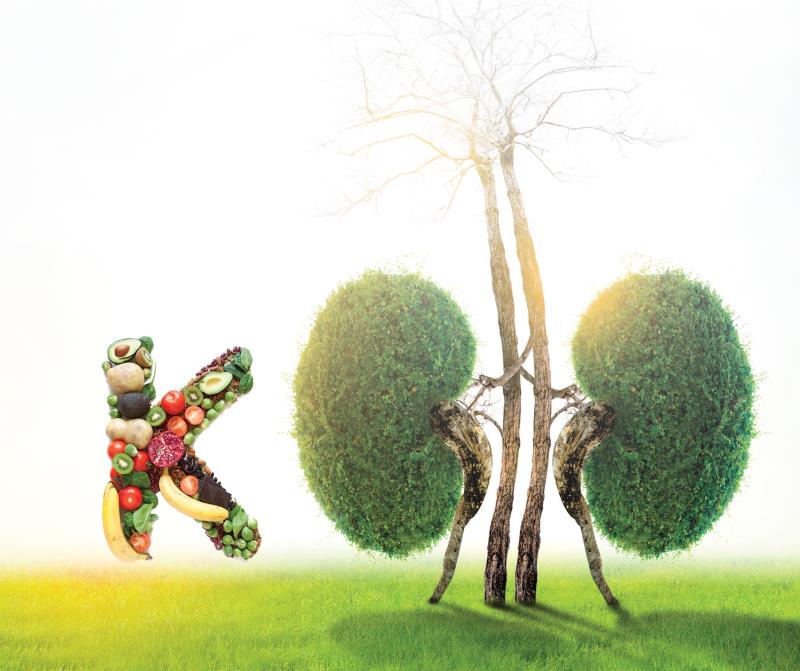HK in CKD: Do diet, HD frequency matter?





Hyperkalaemia (HK) occurrence and recurrence are frequent in advanced CKD*, creating a perfect storm for cardiovascular events and death, says Professor Juan-Jesus Carrero from the Karolinska Institute, Solna, Sweden, at ERA-EDTA 2020. Given these risks, acutely elevated potassium (K+) should merit clinical attention.
Plasma K+ increases across worse CKD stages. In a study by Carerro and team, a U-shaped association was seen between plasma K+ and mortality depending on kidney function, with the lowest mortality in the range of 4.0–4.3 mmol/L. HK was also found to be better tolerated with worse CKD. [Nephrol Dial Transplant 2019;34:1534-1541]
“The relative mortality risk associated with abnormal K+ was lower in patients with CKD 4–5 [eGFR <30 mL/min] vs those with normal kidney function,” said Carrero. “This supports the hypothesis of increased tolerance or adaptation to HK. However, K+ levels of >5.5 mmol/L predict worse outcomes at all CKD stages, and should prompt clinical decisions.”
The consequences of this chronic state of HK in CKD are not well-characterized and may have a negative impact on clinical decisions such as the need to restrict intake of fruits and vegetables or discontinue RAASi** therapy, said Carrero.
Nephrologists often recommend that CKD patients avoid K+-rich foods based on the assumption that dietary intake correlates with serum K+ concentration.
“However, there might be a mismatch here as there is no direct correlation between the amount of K+ in food and the relative rise in serum K+,” said Dr Deborah Clegg from Drexel University, Philadelphia, Pennsylvania, US. “Salt substitutes and K+-containing additives are the types of food that may pose a concern to CKD patients.”
These food products cause a significant increase in overall serum K+ levels, with bioavailability that is significantly high, warned Clegg. “Even more concerning to me is that we advise patients to eat a fair amount of meat, but the meat they might be consuming may contain high levels of preservatives, stabilizers, or emulsifiers.”
Although K+ from different foods is chemically equivalent, other nutrients influence K+ distribution and excretion. Meat-based foods, for example, are net-acid producing and are low in carbohydrates, Clegg said. By contrast, plant-based foods are net-base producing and are high in carbohydrates. Compared with meat-based foods, plant-based foods high in K+ may promote greater distribution of dietary K+ intracellularly (alkaline and insulin-stimulating) and excretion of K+ in stool by increasing faecal bulk.
Consumption of a plant-based diet containing K+ is also associated with lower mortality in CKD. [Am J Kid Dis 2016;67:423-430]
“Dietary K+ intake is a modifiable risk factor in CKD,” she said. “However, strict restriction of K+ in patients with kidney impairment may adversely impact nutrition and contribute to worse outcomes.”
Epidemiological studies suggest that high K+ intake in patients with CKD is associated with cardiorenal benefits, but randomized clinical trials are needed to evaluate whether dietary K+ intake indeed contributes to better cardiorenal outcomes in CKD and end-stage kidney disease (ESKD), Clegg added. “In CKD and ESKD patients receiving RAASi/MRA*** therapy who are at high risk for HK, dietary intervention alone may not be sufficient.”
HK is prevalent in long-term haemodialysis (HD) patients. From large epidemiology studies, up to 50 percent of patients are hyperkalaemic on dialysis at any given time, with K+ levels of >5.1 mmol/L. [ERA-EDTA 2017, poster MP371]
“In the HD community, there’s a certain bravado about tolerating HK. One doctor might not consider HK a problem until K+ is >6 mmol/L. Another might consider 6.5 mmol/L,” said Dr Kieran McCafferty, consultant nephrologist at Barts Health NHS Trust, London, UK. “But data showed the nadir of risk was quite low with serum K+ between 5 and 5.3 mEq/L, conferring the lowest all-cause mortality. More importantly, the increase in mortality associated with HK occurred early such that by the time patients got to 5.6 –5.9 mEq/L, which many considered trivial HK, there’s already a signal for mortality.”

During HD, plasma K+ declines continuously. Once dialysis stops, plasma K+ increases rapidly within 1–2 hours and on until the next dialysis session. The shift in K+ levels during dialysis is not good for the heart. Three-quarters of all arrhythmias occur during or immediately after dialysis and this might be due to K+ changes, said McCafferty.
HD removes K+ from the extracellular fluid (ECF) compartment, but this only represents 2 percent of total body K+. “If we offer long sessions of dialysis to remove more K+, the rate of removal declines exponentially,” he said. “Thus, increasing sessions by 1–2 hours may only have modest benefits. Increasing dialysis frequency may have a more marked effect but can be more difficult logistically.”
During HD, it is also crucial to ensure that dialysis access is functioning optimally. Another approach to lower K+ in dialysis patients is to lower dialysate K+ to make the K+ gradient bigger and remove more K+. However, there are reports of sudden cardiac death in very low (<2 mEq/L) K+ tanks. Higher gradients are also associated with hospitalization, McCafferty warned.
From a HD perspective, it is difficult to adhere to a K+ diet, he said. “An overly restrictive diet is associated with malnutrition, low protein, and low fibre. Malnutrition in ESKD is common and strongly associated with morbidity and mortality. Additionally, malnutrition and diet restriction are associated with poor quality of life in dialysis patients.”
McCafferty acknowledged that data on how to optimally manage HK in dialysis patients have been limited to date. “We can use traditional K+ binders such as sodium polystyrene sulphonate. However, no long-term efficacy has been robustly demonstrated with these therapies in dialysis patients. It is also associated with poor outcomes. It can cause a few side effects such as gastric irritation, anorexia, vomiting and is poorly tolerated,” he said.
Novel K+ binders, for example, sodium zirconium cyclosilicate (SZC) may be considered for management of HK in patients with ESKD. SZC is orally administered, nonabsorbed, and captures K+ through the gastrointestinal tract.
The phase III B DIALIZE trial is the first randomized, placebo-controlled study to evaluate a K+ binder, SZC, for the treatment of HK. [J Am Soc Nephrol 2019;30:1723-1733]
Significantly more HD patients in the SZC arm (41 percent) maintained a predialysis serum K+ of 4.0–5.0 mmol/L during ≥3 of 4 HD sessions after the long interdialytic interval (LIDI) and did not require urgent rescue therapy vs placebo (p<0.001). Seventy percent of those receiving SZC achieved a predialysis serum K+ of 3.5–5.5 mmol/L during ≥3 of 4 HD sessions after the LIDI vs placebo (21 percent), reported McCafferty.
“In the post hoc analysis, there was a difference of only 1 mmol/L in K+ gradient between groups. In terms of safety, SZC was well tolerated.” The incidence of redialysis hypokalaemia was comparable between groups. There was no clinically meaningful change in blood pressure, and interdialytic weight gain, a marker of sodium and fluid retention, was also comparable between groups. The results suggest that SZC may be a good option for predialysis HK in patients with ESKD undergoing adequate HD.